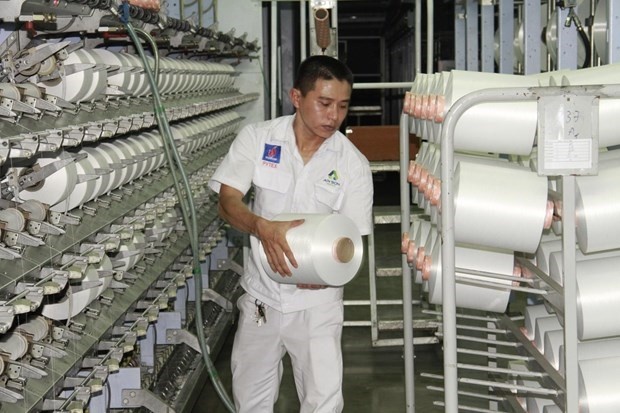Poor-performing projects struggle with restructure
 |
| A worker at Dinh Vu Polyester Fibre Plant (Photo: VNA) |
Last November, thanks to their revitalisation, five projects were removed from the blacklist of 12 poorly-performing state-funded projects of the industry and trade sector, after more than three years of implementing the prime minister’s Decision No.1468/QD-TTg focusing on the shortcomings of some projects in the industry and trade sector.
The five projects comprise Dinh Vu Polyester Fibre Factory, DAP 1-Hai Phong Fertiliser Factory, Phu Tho Biofuel Factory, Binh Phuoc Biofuel Factory, and the Dung Quat Biofuel Factory.
These five were making losses to the extent that their total investment had to be adjusted to a level higher than the original estimate. Further, their capital structures were mainly based on loans with high interest rates. While some projects suffered heavy losses, others lost their equity, and most of them were deemed unable to pay their debts.
Ho Sy Hung, vice chairman of the Commission for Management of State Capital at Enterprises (CMSC) last week said, “The problems of these five projects were handled while respecting the legal entities and without interfering too harshly. Especially with the more resilient projects, the focus will be on early processing based on the obtained results.”
Tackling the seven remaining ventures will likely remain challenging. Nguyen Hung Dung, a member of the Board of Directors of Vietnam Oil and Gas Group (PetroVietnam), said, “Our group has no right to participate in restructuring the Binh Phuoc and Phu Tho projects as it does not hold the controlling stakes.”
PetroVietnam holds shares in five of the 12 projects at a loss, but only holds 29 per cent of the shares of the factory in Binh Phuoc. At the Phu Tho project, PetroVietnam holds 35 per cent.
Dang Hoang An, Deputy Minister of Industry and Trade, commented, “The 12 projects started a long time ago, as far back as 2005. The difficulties of these projects were diverse, such as the increase in the total investment, high borrowing costs, market problems, and contract disputes between the investors and the contractors.”
An reiterated the PM’s direction, “Prime Minister Pham Minh Chinh previously stated that these projects must be dealt with decisively and results shall be reported to the National Assembly, including any problems beyond its authority. The handling of the remaining seven projects should ensure flexibility and suitability for each one of them.”
The CMSC’s Hung said that handling engineering, procurement, and construction (EPC) contracts and financial costs are outstanding issues with the remaining seven projects.
“If these two problems are not solved, enterprises will not be able to compete on the same ground with other businesses. In addition, the failure to release the EPC contract will prevent businesses from being proactive in their activities and production lines,” he said.
Hung explained that the CMSC will work with businesses to re-evaluate their statuses and issues, hoping to empower them again with more autonomy and responsibility, in addition to policy support. For example, enterprises in need of additional capital will be assigned to actively use different sources to restructure projects with many problems. Should they not dispute the EPC contracts, a way could be opened for them to divest and restructure investments.
But Phan Duc Hieu, standing member of the National Assembly’s Economic Committee, warned, “The handling should not break the principles of governance under the Law on Enterprises and the Law on Investment. In dealing with the remaining seven projects, it is necessary to separate the rights and responsibilities of related parties.”
Hieu added, “The processing should take market signals as a measure and be ready for bankruptcy if a product has no market. It is further necessary to carefully calculate the benefits of each project and restructure and reduce costs to improve efficiency, as well as come up with a plan to restructure products to match market needs.”
What the stars mean:
★ Poor ★ ★ Promising ★★★ Good ★★★★ Very good ★★★★★ Exceptional
 Tag:
Tag:
Related Contents
Latest News
More News
- Global partnerships key to Vietnam’s IFC development (December 26, 2025 | 16:18)
- Vingroup pulls out of bid to invest in North-South high-speed railway (December 26, 2025 | 11:42)
- Strengthening supply chains through trade promotions and customs reform (December 24, 2025 | 14:00)
- PM orders investment model for North–South high-speed rail (December 22, 2025 | 17:43)
- LS Eco Energy to invest in Vietnam rare earth sector (December 22, 2025 | 17:31)
- Government moves to establish International Financial Centre (December 21, 2025 | 21:00)
- Vietnam's IFC to target global investment flows (December 21, 2025 | 18:00)
- Two national hospitals expand capacity with new facilities (December 20, 2025 | 09:00)
- Ha Tinh breaks ground on major Vingroup industrial and energy projects (December 19, 2025 | 18:24)
- EVN launches major power infrastructure projects nationwide (December 19, 2025 | 18:17)



















 Mobile Version
Mobile Version